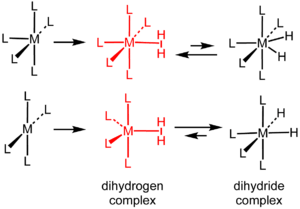Dihydrogen complex

Dihydrogen complexes are coordination complexes containing intact H2 as a ligand.[1] The prototypical complex is W(CO)3(PCy3)2(H2). This class of compounds represent intermediates in metal-catalyzed reactions involving hydrogen. Hundreds of dihydrogen complexes have been reported. Most examples are cationic transition metals complexes with octahedral geometry.
Upon complexation, the H−H bond is extended to 0.81–0.82 Å as indicated by neutron diffraction, about a 10% extension relative to the H−H bond in free H2. Some complexes containing multiple hydrogen ligands, i.e. polyhydrides, also exhibit short H−H contacts. It has been suggested that distances < 1.00 Å indicates significant dihydrogen character, where separations > 1 Å are better described as dihydride complexes (see figure).
Characterization
The preferred method of characterization of dihydrogen complexes is neutron diffraction. Neutrons interact strongly with hydrogen atoms, which allows one to infer their location in a crystal. In some cases, hydrogen ligands are usefully characterized by X-ray crystallography, but often the presence of metals, which strongly scatter X-rays, complicates the analysis. NMR techniques are also widely used. The magnitude of spin-spin coupling, JHD, is a useful indicator of the strength of the bond between the hydrogen and deuterium in HD complexes. For example, JHD is 43.2 Hz in HD but 33.5 Hz in W(HD)(CO)3(PiPr3)2. Dihydrogen complexes typically have shorter 1H-spin-lattice relaxation times than the corresponding dihydrides.
The triangular MH2 subunit has six normal modes of vibration, one of which is mainly of νH−H character. In free H2, this very strong bond absorbs at 4300 cm−1, whereas in dihydrogen complexes the frequency drops to around 2800 cm−1.
Synthesis
Two preparation methods involve the direct reactions with H2 gas. The first entails the addition of H2 to an unsaturated metal center, as originally reported for W(CO)3(P-i-Pr3)2(H2). In some cases, H2 will displace weakly bound ligands, sometimes even halides in favorable cases:
- LnMX + H2 → [LnM(H2)]+ + X−
Many metal hydrides can be protonated to give dihydrogen complexes:
- LnM−H + H+ → [LnM(H2)]+
In such cases the acid usually is derived from a weakly coordinating anion.
History
In 1984, Kubas et al. discovered that the addition of H2 to the purple-colored species M(CO)3(PR3)2 gave a yellow precipitate of mer-trans-M(CO)3(PR3)2(H2) (M = Mo or W; R = cyclohexyl, iso-propyl).[2] This result rapidly led to the discovery of a variety of related complexes such as Cr(H2)(CO)5[3] and [Fe(H2)(H)(dppe)2]+.[4] Kubas et al.'s findings also led to a reevaluation of previously described compounds. For example, the complex "RuH4(PPh3)3" described in 1968 was reformulated as a dihydrogen complex.
See also
References
- ↑ Kubas, Gregory J. (2001-08-31). Metal Dihydrogen and σ-Bond Complexes: Structure, Theory, and Reactivity (1 ed.). Springer. ISBN 0-306-46465-9.
- ↑ Kubas, G. J.; R. R. Ryan; B. I. Swanson; P. J. Vergamini; H. J. Wasserman (1984-01-01). "Characterization of the first examples of isolable molecular hydrogen complexes, M( CO)3(PR3)2(H2) (M = molybdenum or tungsten; R = Cy or isopropyl). Evidence for a side-on bonded dihydrogen ligand". Journal of the American Chemical Society. 106 (2): 451–452. doi:10.1021/ja00314a049.
- ↑ Sweany, Ray L. (1985-04-01). "Photolysis of hexacarbonylchromium in hydrogen-containing matrixes: evidence of simple adducts of molecular hydrogen". Journal of the American Chemical Society. 107 (8): 2374–2379. doi:10.1021/ja00294a030.
- ↑ Morris, Robert H.; Jeffery F. Sawyer; Mahmoud Shiralian; Jeffrey Zubkowski (1985). "Two molecular hydrogen complexes: trans-[M(η2-H2)(H)(PPh2CH2CH2PPh2)2]BF4 (M = Fe, Ru). The crystal structure determination of the iron complex". Journal of the American Chemical Society. 107 (19): 5581–5582. doi:10.1021/ja00305a071.
Further reading
- Burdett, J. K.; O. Eisenstein; S. A. Jackson (1991-12-06). "Transition Metal Didydrogen Complexes: Theoretical Studies". In A. Dedieu (ed.). Transition Metal Hydrides. Wiley-VCH. pp. 149–184. ISBN 0-471-18768-2.
- Burdett, Jeremy K.; John R. Phillips; Mohammad R. Pourian; Martyn Poliakoff; James J. Turner; Rita Upmacis (1987). "Electronic stability of metal-dihydrogen and polyhydrogen complexes". Inorganic Chemistry. 26 (18): 3054–3063. doi:10.1021/ic00265a026.
- Lyons, David; Geoffrey Wilkinson; Mark Thornton-Pett; Michael B. Hursthouse (1984). "Synthesis, X-ray crystal structure, and reactions of dihydridopentakis(trimethylphosphine)molybdenum(II): crystal structure of the carbon dioxide insertion product, (formato-O,O')hydridotetrakis(trimethylphosphine)molybdenum(II)". Journal of the Chemical Society, Dalton Transactions (4): 695–700. doi:10.1039/DT9840000695.
- Kubas, G. J.; R. R. Ryan (1986). "Activation of H2 and SO2 by Mo and W complexes: first examples of molecular-H2 complexes, SO2 insertion into metal-hydride bonds, and homogeneous hydrogenation of SO2". Polyhedron. 5 (1–2): 473–485. doi:10.1016/S0277-5387(00)84951-7. Retrieved 2009-05-02.
- Crabtree, Robert H.; Maryellen Lavin (1985). "[IrH2(H2)2L2]+{L = P(C6H11)3}: A non-classical polyhydride complex". Journal of the Chemical Society, Chemical Communications (23): 1661–1662. doi:10.1039/C39850001661.